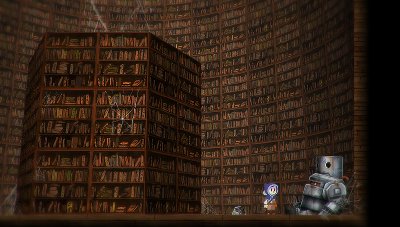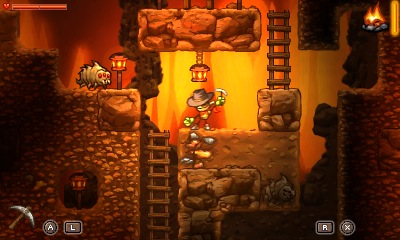Teslagrad

Playing Teslagrad I’m reminded of a couple of articles about difficulty a while back, one from Brett Douville and one from Edmund McMillen. They both, to some extent, discuss how to make games difficult without also making them frustrating – Teslagrad is fairly bad in this area. It really likes creating one-way passages, puzzles and boss fights you have to completely start over if you make the slightest mistake and time-consuming rooms you will have to solve every time you need to get to the other side. Add to this that the physics are occasionally really unpredictable as a physics simulation is at least partially responsible for the platforms you are using and it can occasionally become a really annoying experience.
It falls under the umbrella term “puzzle platformer” but the “puzzles” are usually of the kind that requires quick fingers rather than logical thinking. It doesn’t seem like it intends you to spend a lot of time thinking since the movement is required to be precise even though the physics make it clunky – I want to be forgiving about this since Gish was difficult to control at first but really came alive once you got it, but the penchant for dropping a player down a hole to restart all puzzles when she fails a jump makes it hard. It also gives the impression that it is intended to be more like Super Meat Boy than Braid. The layout feels kind of similar to the early Metroid games in how it takes place in a tower and all rooms spring out from a single central shaft – it is not very similar gameplay-wise though, as there is very rarely any need to backtrack even if you are trying to find everything. Teslagrad is quite simply about starting from the bottom and getting to the top.
Teslagrad looks really great though. The painted sprites look gorgeous and the 3D-backgrounds are used sparingly and to great effect. The animations are fluid and add tons of character to the different creatures that inhabit the game. It manages to tell a story without using any words, an impressive feat considering the events involved. And it is certainly not the worst game out there, especially not if you are in the market for a challenging platformer.
Steamworld Dig

Steamworld Dig opens in a traditional way for Metroidvania games, promising a mystery and exploration of a large mine. It’s almost formulaic in how it presents you with your first few upgrades to unlock new pieces of the mine, but in a good way. It works really well together with the refreshing angle of letting you carve out your own level, and even though the different ways of forcing you to return to the surface feel a bit redundant and annoying, they do serve as a good reminder to keep your path traversable in both directions and your save recent. Also, the extinguishing lamp helps sell the fantasy of exploring a mine really well. It reminds me of Scurge: Hive more than a bit.
The mining itself makes it more of a puzzle game than an exploration game – this is important since there’s not much exploration there. The mine is just as wide from top to bottom and very few upgrades are interesting – nothing is really surprising. A few of them allow you to break new types of blocks or cross bigger chasms, but mostly it is just about letting you progress faster or letting you make longer trips – which in essence are only different ways of making the game less annoying. It doesn’t serve to make the game worse, the customization even improves it slightly by adding a sense of agency, but it is a lost opportunity. Upgrades for the sake of upgrades rather than to introduce variety.
I found it repetitive, the changes introduced by the new types of items and elements did not meaningfully change how the game played. That said, a lot of it comes from high expectations created by a strong introduction and solid core mechanics – I did not mind it being repetitive as it was still good. It just felt like it should have been either shorter or more creative.
Grand Theft Auto V

… It is interesting that I should play Grand Theft Auto V so shortly after playing Call of Duty: Ghosts, in that in terms of the pacing of the single-player campaign they are almost polar opposites. Call of Duty is a rollercoaster ride – a linear stream of action delivered in a short burst – while Grand Theft Auto leaves it up to the player to set the intensity. Even between high-tempo missions you have to repeatedly perform the simple tasks of driving between them – interestingly the mission gameplay itself can be skipped but this cannot. Tom Chick calls it the negative space of interactive entertainment, and pretty much nails what it is about. Would Persona IV (or jrpgs in general) be as good if the dungeon romp or minutiae of stat-maxing was pulled out? Would Shadow of the Colossus be as engrossing if you were transported instantly from one encounter to the next?
This is why it took awhile before I started liking GTAV – at first it felt a bit like a timewaste. Allocating 40 hours to play a single game is a big commitment if you – like me – strive to try and complete many different games rather than indulge heavily in a few. Grand Theft Auto could well have kept only the mission gameplay and the story scenes and still have been an interesting experience – thing is, the negative space gives context to the content. Constantly driving through San Andreas slowly tells you the story of what kind of place it is, what kind of people are living there and how the main characters fit into it. It is not just environmental storytelling about a place where events have already happened, it is very much a place where things are constantly happening and instead of just allowing the player to observe and discover she is invited to take part and experience. In the years after Grand Theft Auto 3 was released, a few magazines theorized about “the perfect game” and used it as a model – while the notion of a perfect game is kind of ridiculous, it is easy to see why Grand Theft Auto springs to mind. The series has always been a pioneer in nonlinear storytelling.
In some respects, it is a game I admire more than personally enjoy – having been through the story, I doubt I’ll play it any more. I don’t doubt I’ll invest another 40 hours whenever GTAVI comes out, though.